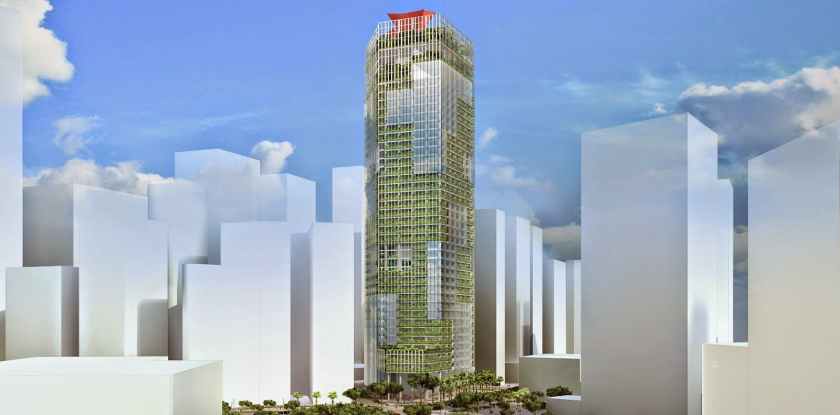CapitaGreen


1) BREATHABILITY
- Vertical air movement –
- 45 meter (2) tall wind-catchers atop the skyscraper are oriented towards the prevailing wind direction (1). Designed to scoop winds at this elevation, they channel air down a core known as the ‘Cool Void’ (5).

- Horizontal air movement –
- Air from the ‘Cool Void’ spreads horizontally through the levels, reducing load on the air-conditioning system.

Plan diagram showing wind from the ‘Cool Void’ spreads horizontally; Graphics: Author - The facade is created of 2 layers of glass separated by 2 meters. The outer layer is a complex permeable arrangement of flat glass panels and narrower glass fins (7), allowing air to circulate. This layer also shelters the vegetation between the 2 layers of glass.

Double Skin Facade for air circulation and protecting plants; Image: Green A Consultants
- Unit thick principle –
- This building has a large footprint of around 50 m X 60 m. Thus the Unit Thick Principle, which would require a footprint width of 15 m or lower may not be applicable.*
*The Unit Thick Principle, is a design technique applied by WOHA Architects, Singapore; in many of their projects. The figure ’15 m’, is an assumption based on multiple WOHA Project case-studies.
2) INTEGRATION WITH GREEN AND BLUE SYSTEMS
According to Toyo Ito, Singapore has lost a lot of its forests and green (3). This building shows his effort to replace the lost horizontal green, Vertically! The plants will be irrigated using various water-saving techniques such as Rain Water Harvesting (5).
- Vertical Green spaces –
- Almost 55 per cent (2) of the perimeter of the facade is covered with flourishing plants and vertical greenery.
- The East and West facades that are usually more difficult to shade, have larger (6) amounts of greenery.

Axonometric diagram showing Vertical Greenery; Graphics: Credits below
- Horizontal Green spaces –
- Level 5, 14 and 26 have Sky Terraces
- There is a Sky Forest on Level 40 (1)

Sectional diagram showing location of Sky terraces and Sky forest; Graphics: Author
Box 1: Addressing East and West Facades
These faces of the building are difficult to shade, as they receive low angle rays from the rising and setting sun. Common shading features such as horizontal projections, usually fail in such situations. Our case-studies explain methods to address these tricky areas of the building.
- Park Royal – Using self-shading form projections
- CapitaGreen – Larger amount of greenery to shade the facades
3) OTHER ENERGY SAVING STRATEGIES
- Sun-Pipes (1) are used at restaurants and gyms. Sun-Pipes are light tubes or tunnels, used for transmitting natural light usually from the roof, to areas less accessible to daylight. Our post on E@BS, talked of DPR’s Phoenix regional office, which also utilizes solar tubes to bring natural light to office spaces.
- CapitaGreen has one of the highest floor to ceiling heights for office buildings – 3.2 m. This along with large windows, allows natural light to enter and reduces the need for artificial lighting (6).
This building along with Park Royal, demonstrates how Passive and Sustainable design can be implemented in Commercial buildings, despite budget/ space constraints and strict program controls.
We hope you enjoyed this segment. The post raises further questions that we will try and answer in future posts –
We saw that CapitaGreen has 2 main large sustainable features that extend across the length of the building – the ‘Cool Void‘ Core and the Vertical Green facade. These features have multiple benefits such as –
- The Cool Void as well as the Greenery provide cooling, thus reducing load on air-conditioning.
- The Greenery provides cooling of the surroundings through evapotranspiration, and thus positively impacting micro-climate and reduces the Urban Heat Island effect.
- The plants help provide cleaner air through photosynthesis and also create general feeling of well-being (4) among occupants.
However, CapitaGreen is a large commercial building with multiple tenants. When occupied, it is possible that conflicting questions might arise as follows –
Q) Which party would be in-charge of maintenance of the facade and greenery at various levels? (Centrally managed or by tenants?)
Q) The continuous internal core has an interface with multiple offices and organizations. Again, who would be responsible for maintenance? (Centrally managed or by tenants) Would this interface pose any security or privacy issues?
Q) Are there any Sustainable guidelines for future tenants to follow regarding materials, furniture, lighting, fixtures – to maintain the Green Mark Platinum standard? (This could be similar to LEED BD+C: Core and Shell, where the tenants are given design and construction guidelines, to educate them in implementing sustainable design and construction features in their tenant fit outs)
We leave you with these questions for now. Feel free to let us know answers to the above, or your thoughts, suggestions, queries, opinions. Your views will make this exploration richer.
Thank you and see you next week!
Credits:
Graphics : All graphics are produced as part of a team project for M.Sc. Integrated Sustainable Design at National University of Singapore (Building Semester – Stage 1 – Complex Living Systems). Group Members – Gajender Kumar Sharma, Aditi Bisen, Huang Hongbo, Zhao Yanming
Text: Aditi Bisen
References/ Additional Reading:
- GreenA Consultants. Capitagreen:: GreenA Consultants. http://www.greenaconsultants.com/our-work/capitagreen/. Accessed July 8, 2018.
- CTBUH. CapitaGreen – The Skyscraper Center. http://www.skyscrapercenter.com/building/capitagreen/13978. Accessed July 8, 2018.
- Zachariah NA. Toyo Ito’s “big tree in the city”, Home & Design News; Top Stories – The Straits Times. https://www.straitstimes.com/lifestyle/home-design/toyo-itos-big-tree-in-the-city. Accessed July 8, 2018.
- Macdonald F. BBC – Culture – Ten of the world’s most incredible rooftops. http://www.bbc.com/culture/story/20170106-incredible-rooftops-around-the-world. Accessed July 8, 2018.
- CapitaLand Commercial Trust. CapitaGreen | CapitaLand Commercial Trust. http://www.cct.com.sg/our-properties/singapore/capitagreen/. Accessed July 8, 2018.
- RSP. CapitaGreen | RSP Architects Planners & Engineers’s Portfolio. http://www.rsp.ae/projects/project/capitagreen. Accessed July 8, 2018.
- RWDI. CapitaGreen – RWDI Consulting Engineers and Scientists – RWDI. http://rwdi.com/en_ca/projects/capitagreen. Accessed July 8, 2018.
